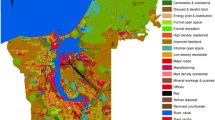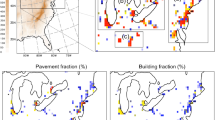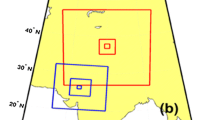Abstract
Numerical simulations of thermal field variation due to land use changes, such as the reduction of the lacustrine system and the growth of the urban area, in the Basin of Mexico are presented. It is shown that the historically recorded warming in the basin could be attributed, not only to the growth of the urban area, but more importantly to the drastic reduction in the lacustrine system that existed in the basin.
Similar content being viewed by others
References
Escurra, E. and Turner, B. L.: 1990, The Basin of México in the Earth as Transformed by Human Action, Cambridge University Press, Cambridge, U.K., p. 495.
Flassak, Th.: 1990, ‘Ein Nichtydrostatisches Mesoskaliger Modell der Planetaren Grenzschicht’, Fortschr.-Ber, VDI, 15, 74, p. 203.
Flassak, Th. and Moussiopoulos, N.: 1988, ‘Direct Solution of the Helmholtz Equation Using Fourier Analysison the CYBER205’, Environ. Software 3, 12-16.
Jacobs, C. A. and Pandolfo, J. P.: 1974, ‘A Description of a General Three-Dimensional Simulation Model of a Coupled Air-Water/-or Air-Land Boundary Layer’, CEM Report 4131-509a.
Jauregui, E.: 1986, ‘The Urban Climate of México City’, Tech. Conf. on Urban Climatology, WMO-652, pp. 26-45.
Jauregui, E.: 1988, ‘Local Wind and Air Pollution Interaction in the México Basin’, Atmósfera 1, 131-140.
Jauregui, E.: 1990, ‘Effects of Revegetation and New Water Bodies on the Climate of Northeast México City’, Energy Buildings 15 (16), 447-455.
Jauregui, E.: 1993, ‘México City's Urban Heat Island at the End of the XIX Century (Spanish)’, Invest. Geogr. Boletín 26, 31-39.
Jauregui, E.: 1997, ‘Heat Island Development in Mexico City’, Atmos. Environ. 31, 3821-3831.
Jauregui, E. and Romales, E.: 1996, ‘Urban Effects on Convective Precipitation in México City’, Atmos. Environ. 30, 3383-3389.
Kunz, R. and Moussiopoulos, N.: 1997, ‘Implementation and Assessment of a One-Way Nesting Technique for High Resolution Wind Flow Simulations’, Atmos. Environ. 31, 3167-3176.
Lu, R., Turco, R., and Jacobson, M. Z.: 1997, ‘An Integral Air Pollution Modeling for Urban and Regional Scales. Part II: Simulation for SCAQS 1987’, J. Geophys. Res. 102 (D5), 6081-6098.
Moreno, M.: 1977, ‘Joaquín Velázquez de León y sus trabajos científicos sobre el Valle de México’, Inst. de Inv. Históricas, Serie 25, Novohispana, UNAM.
Moussiopoulos, N.: 1985, ‘A Numerical Simulation of the Sea-Breeze in Athens’, Pageoph 123, 321-335.
Moussiopoulos, N.: 1987, ‘An Efficient Scheme to Calculate Radiative Transfer in Mesoscale Models’, Environ. Software 2, 172-191.
Moussiopoulos, N.: 1989, ‘Mathematische Modellierung Mesoskaliger Ausbreitung in der Atmosphare’, VDI-Dusseldorf, p. 307.
Moussiopoulos, N.: 1990, ‘Ein Nicht-Hydrostatisches Mesoskaliges Modell zur Beschreibung der Dynamic der planetaren Grenezschicht’, VDI-Dusseldorf, p. 203.
Moussiopoulos, N.: 1994, ‘The EUMAC Zooming Model; Model Structure and Applications; Eurotrac International Scientific Secretariat’, Garmisch-Partenkirchen, p. 307.
Moussiopoulos, N.: 1995, ‘The APSIS Activity’, Atmos. Environ. (Special Issue) 29, 153.
Moussiopoulos, N., Sahm, P., Kunz, R., Vogele, T., Schneider, Ch., and Kessler, Ch.: 1997, ‘High-Resolution Simulations of the Wind Flow and Ozone Formation during the Heilbronn Ozone Experiment’, Atmos. Environ. 31, 3177-3186.
Oke, T. R.: 1973, ‘City Size and the Urban Heat Island’, Atmos. Environ. 7, 769-779.
Oke, T. R.: 1981, ‘Canyon Geometry and the Nocturnal Heat Island: Comparison of Scale Model and Field Observations’, J. Climatol. 1, 237-254.
Oke, T. R.: 1982, ‘The Energetic Basis of the Urban Heat Island’, Quart. J. Roy. Meteorol. Soc. 1, 455.
Oke, T. R., Zeuner, G., Jauregui, E.: 1992, ‘The Surface Energy Balance in Mexico City’, Atmos. Environ. 26B (4), 433-444.
Pielke, R,: 1984, Mesoscale Meteorological Modeling, Academic Press.
Schneider Ch., Kessler, Ch., and Moussiopoulos, N.: 1997, ‘Influence of Emission Simulations of the Wind Flow and the Ozone Level Predictions for the Upper Rhine Valley’, Atmos. Environ. 31, 3187-3206.
Smolarkiewicz, P. K.: 1984, ‘A Fully Multidimensional Positive Definite Advection Transport Algorithm with Small Implicit Diffusion’, J. Comput. Phys. 54, 325-362.
Wellens, A.: 1993, Analisis Matemático de la Dispersion Atmósferica en la Ciuadad de México, Master Thesis, Universidad Nacional Autónoma de México.
Willmott, C. J.: 1981, ‘On the Validation of Models’, Phys. Geog. 2, 184-194.
Author information
Authors and Affiliations
Rights and permissions
About this article
Cite this article
Jazcilevich, A., Fuentes, V., Jauregui, E. et al. Simulated Urban Climate Response to Historical Land Use Modification in the Basin of Mexico. Climatic Change 44, 515–536 (2000). https://doi.org/10.1023/A:1005588919627
Issue Date:
DOI: https://doi.org/10.1023/A:1005588919627




